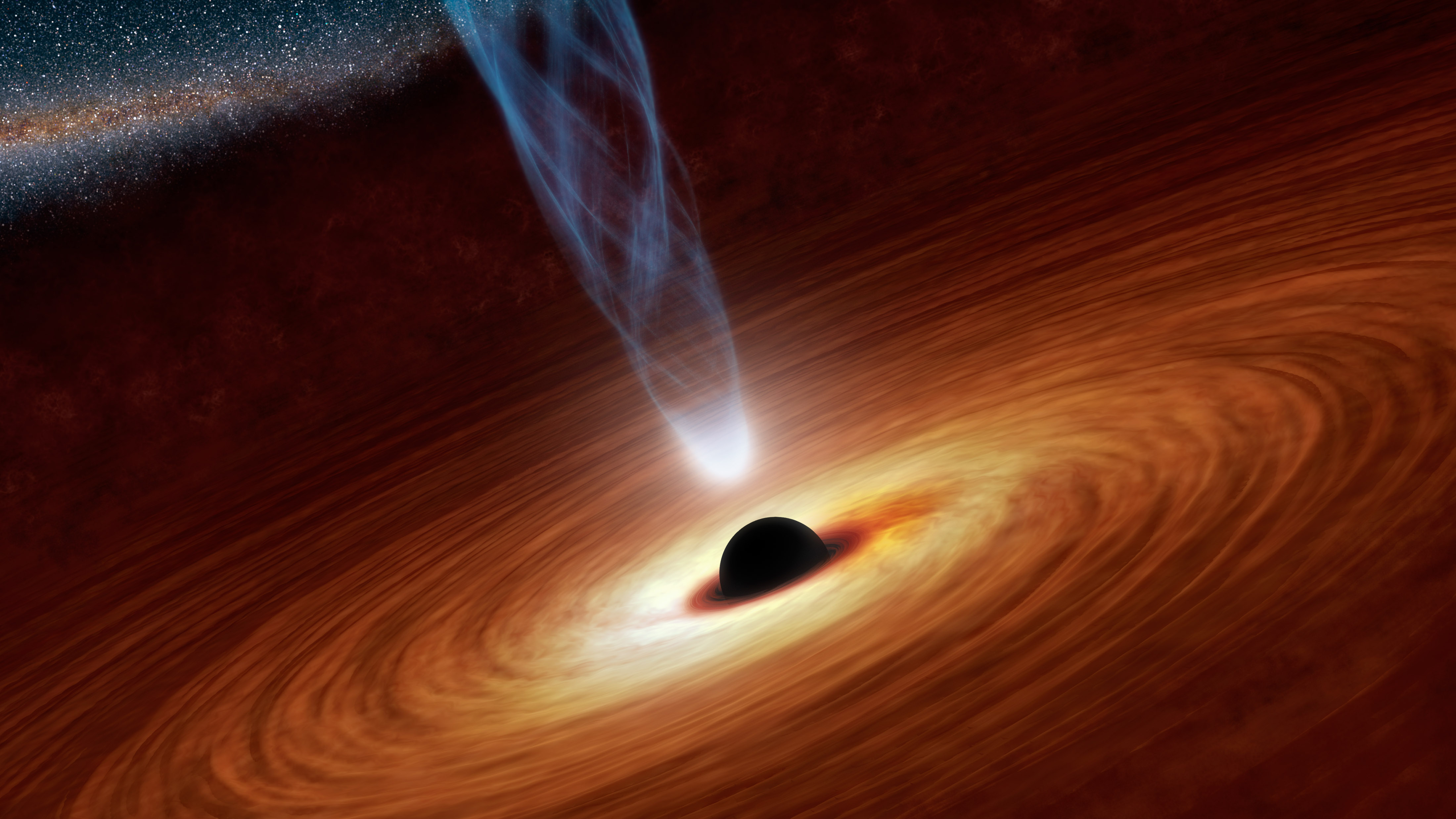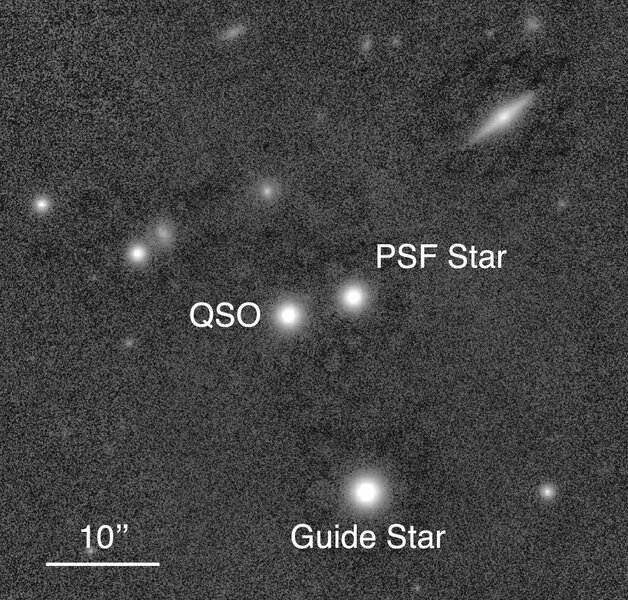Create a free profile to get unlimited access to exclusive videos, sweepstakes, and more!
Why is this anemic galaxy’s central black hole so beefy?

Well, I have a favorite new science journal paper title.
What? You don't have one? Well, maybe you do now.
I love this: "A Catastrophic Failure to Build a Massive Galaxy around a Supermassive Black Hole at z = 3.84". Ha!
The reason I love it is because it turns a usual question on its head. To understand how, I have to do some explaining. And hey: I love that too! So let's take a look.
First, you're probably wondering about that z = 3.84 thing. This is how astronomers refer to distance when we're talking about galaxies a long way away. The Universe is expanding, and that means, on large scales, galaxies are all moving away from each other. We can see this as a wavelength shift in their light, which you've heard of: redshift (similar to a Doppler shift). The farther away a galaxy is, the faster it's moving away from us, and the greater the shift in its light.
The amount the wavelength is shifted is denoted by the letter z. So a z=1 redshift is a galaxy whose wavelength has been shifted by 100%, so its wavelength is doubled. A z of 2 has its wavelength tripled, and so on. So a galaxy whose wavelength has been shifted by a factor of 4.84 is said to have a z of 3.84.
To get a distance from that you need a whole lot of assumptions about the rate of expansion, the geometry of spacetime, and more. But making the standard assumptions there, a galaxy at z=3.84 means it's so far away the light we see from it took about 12 billion years to get here. So we see this galaxy as it was less than two billion years after the Big Bang. It's actually way more complicated than that, but close enough for now.
So. What's the deal with this galaxy then?
We know that all big galaxies have supermassive black holes (SMBHs to those in the know) in their centers, and that these SMBHs grew to their enormous sizes early on. These black holes affect the way the galaxy grows, which in turn also affects how the SMBH grows, too (I've written about this many times, like here and here).
It's a bit of a mystery how they grew so big so quickly. They can only eat matter so rapidly, so growing to millions or billions of times the Sun's mass in less than a couple of billion years is difficult to explain. There are lots of ideas, but astronomers are still making observations to see which ideas are supported by what we actually see.
The paper in question is looking at a galaxy called SDSS J163909+282447.1. It's an active galaxy, which means the black hole in its core is actively feeding, and as that matter falls in it gets extremely hot and bright. That's good! That light is how we can see this galaxy at all at such a vast distance, and it also means astronomers can measure the light from the matter swirling around the black hole. How fast that material moves depends on the gravity of the black hole, which in turn depends on its mass.
Using ALMA, the Atacama Large Millimeter/submillimeter Array in Chile, astronomers were able to measure the velocity of a disk of material around the galaxy's black hole, by looking at the Doppler shift in the light from carbon monoxide gas as it whirled around. Using some fairly well understood assumptions, they find that the black hole has a mass of 25 billion times that of the Sun! Supermassive indeed.
But then a funny thing happened. There's a relationship between the mass of the central black hole and the mass of the galaxy, since, at very early times, the two depend on each other as they grow. According to this relation, the galaxy should have a stellar mass (literally, the mass of all the stars combined) of about a trillion times the Sun's mass.
That's a lot of stars, and they would emit a lot of light. However, the astronomers didn't detect any light from stars in the galaxy! None. That puts an upper limit to the mass of stars there (if there were more than this amount they'd see them) — about 60 billion solar masses. That's a factor of 16 too small! They used a different method to determine the stellar mass and found it to be less than 15 billion, which is even worse.
Either way, the galaxy mass is too small to have a black hole that big! And it's not by a little; the galaxy misses the mark by a huge margin. Hence the paper's title. [However, see note at the end of this post below.]
So how can this be? The authors tried to think of ways they could miss the galaxy's stars. Maybe the galaxy is really small in size, so much so that the galaxy is too small to see it clearly. But if that were true this would be an incredible dense galaxy, far more tightly packed than anything ever seen. Unlikely.
Maybe it's the opposite problem, and the galaxy is so spread out its starlight is too faint to detect. That doesn't seem likely, though it's not impossible, but there's no way to test it without a 'scope like the James Webb Space Telescope. So that has to be tabled for now.
Other possibilities are raised, but it's not clear how much water they hold. In the end, this galaxy may very well be seriously understaffed, and that's weird.
What's ironic is that this problem with the galaxy sits right on top of that bigger problem I mentioned earlier, that we still don't quite understand how black holes can get so friggin' big so quickly. I have to wonder if these two problems are related; the black hole grew at the expense of the galaxy, perhaps, somehow quenching the galaxy's growth while it grew huge. I don't know how that might work, but I've learned in my years dealing with astronomical puzzles that if you have an object with two odd things about it, chances are they're connected.
So this turns out to be a pretty cool galaxy. I expect it'll have other telescopes aimed its way over time (hopefully JWST can, har har, shed some light on this). Maybe more like it will be found, too; the farther away we look, the more weirdness we see. It can be frustrating, sure, but it's also what makes this sort of work so exciting.
Mysteries abound at the edge of the observable Universe! And that always means there's more fun to be had.
[Note (added 1 Nov 2019 at 17:00 UTC): After posting this I received an email from astronomer Tod Laur, who has studied the relationship between supermassive black holes and the mass of their host galaxies. In a 2007 paper, he and his coauthors point out that it can be difficult to extrapolate the mass of an underlying galaxy hosting an extreme SMBH when it's very far away; the relationship between them has a lot of scatter (meaning, the relationship isn't as tight as you'd like) that makes finding the host galaxy mass fraught with issues — in a nutshell, extremely massive SMBHs are not as rare as extremely massive galaxies, so you're more likely to see an outlier SMBH in a medium-sized galaxy than in a monster galaxy). I'll note that the authors of the paper on this particular galaxy do concede that point, and in their paper (on page 4) say that even when looking at Lauer's results from 2007 this galaxy stands out as undermassive. At this point though, I'll have to leave it to the experts to hammer this out! If this galaxy is just an extreme example of scatter in a known relationship, it still presents an ineresting problem on why it's so extreme and how the black hole got so big.]





























